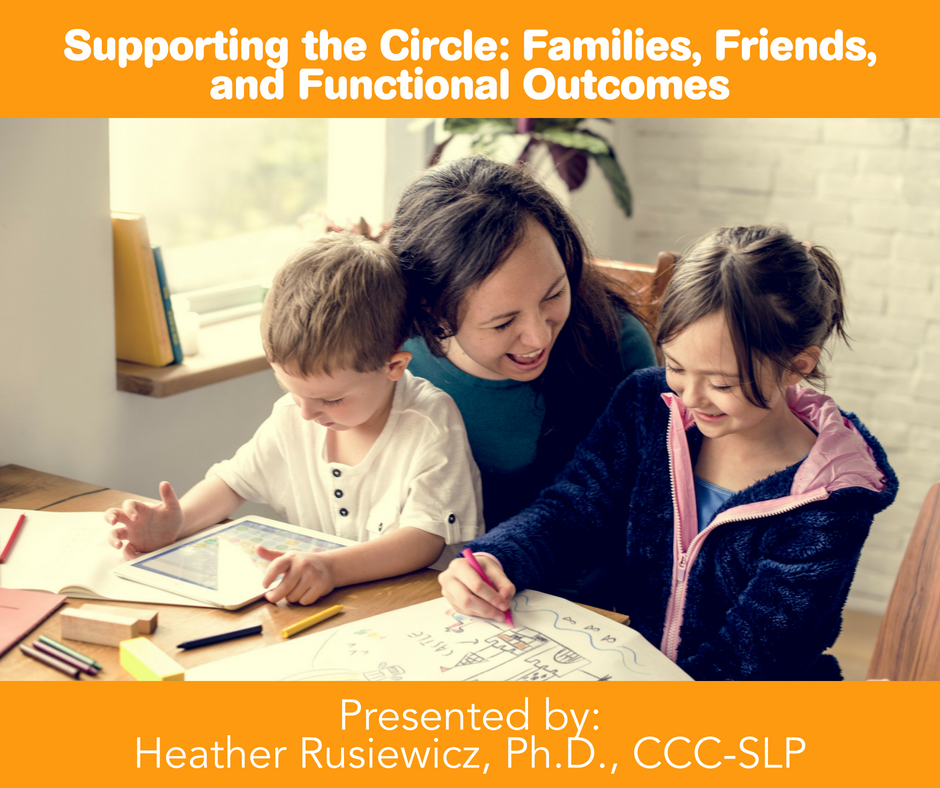
17 Dec Supporting the Circle: Families, Friends, and Functional Outcomes
Course Abstract:
The management of childhood apraxia of speech (CAS) often intensely focuses on speech production objectives. While addressing speech sound skills is essential during intervention, it is also important to expand the therapeutic focus beyond the phoneme and even beyond the client. Consideration of the experiences of children with CAS and their families will help lead to more functional outcomes in day-to-day interactions. This presentation will review literature on the impact of CAS and the family unit according to the experiences and perceptions of parents. Ways in which to incorporate the larger family and social circles in patient- and family -centered care practices will be discussed.
Presented By: Heather Leavy-Rusiewicz, Ph.D., CCC-SLP
This course is offered for 0.15 ASHA CEU’s (Intermediate Level, Professional area)

Learning Objectives
- Describe the four pillars of person-/family-centered care
- Identify ways to assess and target functional outcomes for individuals with CAS
- Develop at least three strategies to incorporate and/or advocate for person-/centered care into the clinical management of individuals with CAS
Timed Agenda
Minutes 1-5: Introduction
Minutes 6-11: Pivoting typical intervention structure of treatment of CAS and tenets of person-/family-centered care
Minutes 12-16: Presentation of ICF-Y and its application to speech sound disorders, including CAS
Minutes 17-32: Reviewing literature and personal statements regarding functional outcomes and experiences of individuals with CAS and their families
Minutes 33-43: Describing mechanisms to assess and integrate person-/family-centered care into practice
Minutes 44-54: Presenting mechanisms to assess and target functional outcomes for those with CAS
Minutes 55-65: Summary
Minutes 65-90: Questions and Answers
Course Abstract:
The management of childhood apraxia of speech (CAS) often intensely focuses on speech production objectives. While addressing speech sound skills is essential during intervention, it is also important to expand the therapeutic focus beyond the phoneme and even beyond the client. Consideration of the experiences of children with CAS and their families will help lead to more functional outcomes in day-to-day interactions. This presentation will review literature on the impact of CAS and the family unit according to the experiences and perceptions of parents. Ways in which to incorporate the larger family and social circles in patient- and family -centered care practices will be discussed.
Presented By: Heather Leavy-Rusiewicz, Ph.D., CCC-SLP
This course is offered for 0.15 ASHA CEU’s (Intermediate Level, Professional area)

Learning Objectives
- Describe the four pillars of person-/family-centered care
- Identify ways to assess and target functional outcomes for individuals with CAS
- Develop at least three strategies to incorporate and/or advocate for person-/centered care into the clinical management of individuals with CAS
Timed Agenda
Minutes 1-5: Introduction
Minutes 6-11: Pivoting typical intervention structure of treatment of CAS and tenets of person-/family-centered care
Minutes 12-16: Presentation of ICF-Y and its application to speech sound disorders, including CAS
Minutes 17-32: Reviewing literature and personal statements regarding functional outcomes and experiences of individuals with CAS and their families
Minutes 33-43: Describing mechanisms to assess and integrate person-/family-centered care into practice
Minutes 44-54: Presenting mechanisms to assess and target functional outcomes for those with CAS
Minutes 55-65: Summary
Minutes 65-90: Questions and Answers
Credentials:
Hours of Operation:
Treatment locations:
Address:
,
Phone:
Email:
Overall Treatment Approach:
Percent of CAS cases:
Parent Involvement:
Community Involvement:
Professional consultation/collaboration:
Min Age Treated:
Max Age Treated:
Insurance Accepted:




